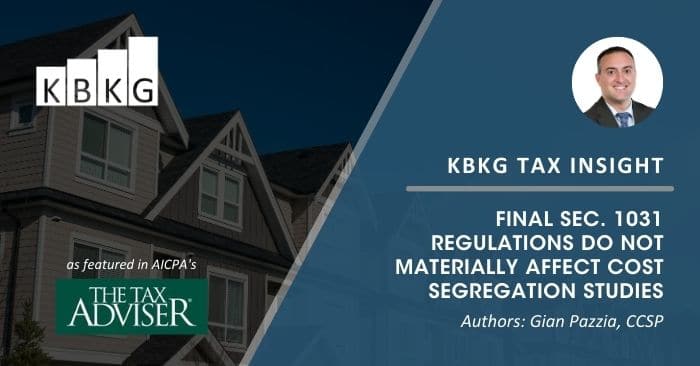As featured in AICPA Tax Adviser – February 4, 2021
In November 2020, the IRS issued final regulations defining real property for Sec. 1031 like-kind exchanges (T.D. 9935). The new regulations were needed because the Tax Cuts and Jobs Act (TCJA), P.L. 115-97, amended Sec. 1031 so personal property is no longer eligible for a like-kind exchange.
As a result of this change to the 1031 exchange rules, many tax professionals were concerned that any five- and seven-year property identified through cost segregation would need to be handled outside of a Sec. 1031 exchange. The final regulations clarify that nearly all building components identified as five and seven-year property through a cost segregation study are, in fact, real property under Sec. 1031. Compared to pre-TCJA rules, there is no material change in the tax treatment of a building involved in a like-kind exchange, where a cost segregation study has been performed.
Background
The proposed Sec. 1031 regulations issued in June 2020 attempted to significantly change the definition of real property that has been long established by the courts. Historically, case law has generally pointed to state law definitions of real and personal property, which largely describe items affixed to a building, such as electrical and plumbing fixtures, as real property for like-kind exchange purposes. There was no correlation between these definitions and definitions used for federal tax depreciation purposes. As a result, building components could have a five-year or seven-year life for tax depreciation, but were still real property under Sec. 1031.
The proposed Sec. 1031 regulations initially defined real property in a way that was similar to the definition used for tax depreciation purposes. In many cases, this would have created significant federal and state taxable income from the exchange of real estate that did not exist before TCJA, as well as increase the burden on taxpayers to identify and value these components. After several taxpayers submitted comments urging the IRS not to adopt the new definition of real property (including KBKG’s comments), the IRS changed course and removed language that departed from historic case law.
KBKG Insight:
Several of KBKG’s comments were addressed by the IRS in the Summary of Comments section issued along with the final regulations. We are proud to influence change in this area and we commend the IRS for carefully considering our concerns as well as those submitted by various industry experts.
To help clarify how a Sec. 1031 transaction is handled when cost segregation has been performed on a relinquished property, here is the following case study.
KBKG Case Study:
A property is sold in a Sec. 1031 exchange for $1 million with a corresponding land value of $200,000 and building value of $800,000. The property was originally purchased for $500,000 and held for 10 years. The replacement property was purchased for $1 million. A cost segregation study was performed on the relinquished building and replacement property resulting in the following allocations:
| Relinquished property (upon acquisition) |
Relinquished property (upon sale) |
Replacement Property | |
|---|---|---|---|
| Five-year | $40,000 | $80,000 | $80,000 |
| 39-year property | $360,000 | $720,000 | $720,000 |
| Land | $100,000 | $200,000 | $200,000 |
| Total | $500,000 | $1,000,000 | $1,000,000 |
This taxpayer fully depreciated the five-year property components by the time the exchange occurs. Assuming that all the five-year property identified in the cost segregation study is affixed to the building and considered real property for Sec. 1031 exchange purposes, this taxpayer avoids taxable gains and Sec. 1245(b)(4) recapture because there is at least an equal amount ($80,000) of five-year components in the replacement property.
Incidental Personal Property: 15% Rule
In addition to updating the definition of real property, the IRS finalized a rule providing that exchange funds can be used to purchase real property that contains incidental personal property. Personal property is incidental to real property acquired in an exchange if (1) in standard commercial transactions, the personal property is typically transferred together with the real property, and (2) the aggregate fair market value of the incidental personal property transferred with the real property does not exceed 15% of the aggregate fair market value of the replacement real property.
KBKG Case Study:
A taxpayer sells an apartment building for $3.1 million and exchanges into a replacement property worth $3 million plus associated appliances valued at $100,000. Since $100,000 is less than 15% of $3.1 million, the exchange funds can be used to acquire the $100,000 of personal property. Please note, the taxpayer must still treat the $100,000 as personal property for depreciation purposes and may need to recognize gain if sold in the future.
Analysis
In summary, for Sec. 1031 exchange purposes, property is real property if it is (1) classified as real property under state or local law; (2) specifically listed as real property in the final regulations; or (3) considered real property based on all of the facts and circumstances, under factors provided in the regulations. Accordingly, if property is not real property under state law, it can still satisfy the second or third test for like-kind exchanges.
In addition, the term real property under Sec. 1031 means
“Improvements to land” refers to inherently permanent structures and the structural components of inherently permanent structures. The regulations list examples of inherently permanent structures, and if the property considered is not listed, a five-factor test applies to make a determination.
The regulations define a structural component and list examples. If a component of a building is not listed, the determination of whether the component is a structural component is based on the following factors:
- The manner, time, and expense of installing and removing the component;
- Whether the component is designed to be moved;
- The damage that removal of the component would cause to the item itself or to the inherently permanent structure to which it is affixed; and
- Whether the component is installed during construction of the inherently permanent structure.
Cost Segregation May Be Key
For all intents and purposes, most items identified in a cost segregation study that are affixed to a building will satisfy the requirements above and remain eligible for a like-kind exchange. The regulations also provide additional examples. While there is still some subjectivity involved, tax practitioners have closure on a longstanding concern.
The definition of personal property and real property for Sec. 1031 purposes has been a source of confusion for many years for taxpayers who conduct cost segregation studies of real property. These final regulations provide clarity and are taxpayer friendly because they allow the continued deferral of tax when a building is exchanged and a cost segregation was performed on the relinquished property.
Authors: Gian Pazzia, CCSP
About the Author
 Gian Pazzia, CCSP – Principal
Gian Pazzia, CCSP – Principal
Pasadena
Gian is a founding Principal at KBKG. He is a subject matter expert in their Cost Segregation group and for their 263(a) Repairs vs. Capitalization services. Gian is a former President (2013-2015 term) of the American Society of Cost Segregation Professionals and has held a seat on their Board of Directors for a decade. » Full Bio


